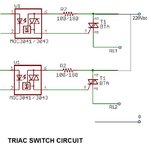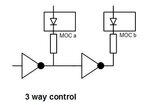mamech
Full Member level 3

Hello Everyone
I have tried to do action-like 3 way switch using 2 transistors an pnp and an npn.
But I am asking about the simplest way that I can do the same with a triac.
I think I will need 2 triacs to do so.right?
Thanks
I have tried to do action-like 3 way switch using 2 transistors an pnp and an npn.
But I am asking about the simplest way that I can do the same with a triac.
I think I will need 2 triacs to do so.right?
Thanks



